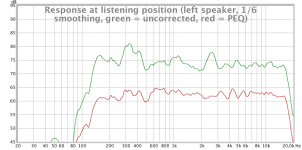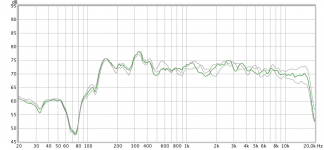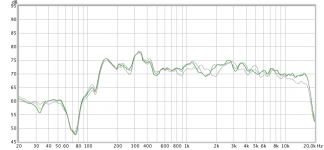A PEQ where you can't adjust the center frequencies to anything you like is not properly parametric. I don't know what you mean by "quasi nil".
In regards to phase. ...A PEQ doesn't deal with phase, the adjustable "Q" is not a recipe for phase issues. ...Or unless it has a separate "phase" correction control.
...Between the drivers of each speaker (x-overs), the subwoofer's exact crossover point, its slope, and each loudspeaker's positioning in relation to the listener(s) main position and to the other loudspeakers in the room. Each speaker's position has different acoustic dispersion in the room and @ the listening position(s).
And yes, without an adjustable "Q" we have a graphic equalizer.
Last edited:
Exactly the reason why I've limited the topic. Mixed phase EQ isn't available to the masses. There is no multichannel convolution box. PEQ on the other hand is everywhere (miniDSP, DCX2496, UMC-200, ...).
PEQ means minimum phase filters. We even haven't touched that topic yet.
PC is multichannel convolution box.
With sourceforge convolver plugin for Windows Media Player I have tested 8 channels with >32k sample filter kernels with Pentium III 500MHz laptop.
With P4 2.6GHz single core CPU hit is quite acceptable.
VST convolver plugin works with Console, and as I understand Reaper. My experience with Console is quite good. I can switch between digital and analog inputs of soundcard and control 8 analog outs plus digital out.
For DSP based Pluto Clone I do 2.1, using 5 channels. Convolver sums left and right with application of sub filter for sub. Works great.
Whole setup is scalable. Master digital source can be split to multiple soundcards, each with own PC.
JRiver Media player features multichannel convolution engine with 64bit computational capacity. From looks of their forum it works quite well.
With straight PEQ approach speaker IR(s) are captured and used as model for selection and digital generation of clean filters. Manual selection of filters by trial and error is tedious, but can, and for many, does yield desirable results. Computer based selection and optimization for N filters is a straight forward. First order solutions may be considered as all filters starting at single time reference. Multiple time base may be employed, accounting for various reflections from speaker exterior, interior, driver structure, and of course room reflections. Such approach can yield perfect IR, but at expense of being for single, and very small listener position, especially as corrected frequencies increase.
Practical limits are mostly from basic diffraction pattern set up by cone/horn profile. Wider lobes/lower frequencies of tweeter are generally correctable to large extent. Correction for finer detail fluctuations is possible, but again at expense of smaller listening region of applicability.
This is where looking at smoothed spectrum via shorter windows, gating, and other computational methods applied to spectrum is useful for identifying the fewest number of filters that provide the greatest overall improvement in response.
Multiple seat correction is compromise for which lowest frequencies are still readily correctable over the wider area, but leads to best approach at higher frequencies of using fewer, wider filters.
Direct response of speaker is priority. It is how sound enters room. At lowest frequencies room is part of speaker. When room is just too small, and/or too reflective, EQ for room is waste of time, and room should have damping added. Bright rooms typically work well with limited types of recording and more background low level listening. The brighter the room, the higher the Q of modal peaks.
Direct use of measured IR via inversion techniques requires microphone with flat response , or appropriate generation of microphone correction filter based on its calibration data. Generally straight forward. More important is high signal to noise ratio, so as not to add too much noise to signals via convolution process.
In regards to phase. ...A PEQ doesn't deal with phase, the adjustable "Q" is not a recipe for phase issues. ...Or unless it has a separate "phase" correction control.
...Between the drivers of each speaker (x-overs), the subwoofer's exact crossover point, its slope, and each loudspeaker's positioning in relation to the listener(s) main position and to the other loudspeakers in the room. Each speaker's position has different acoustic dispersion in the room and @ the listening position(s).
And yes, without an adjustable "Q" we have a graphic equalizer.
Not true. A peak corrected with matched filter for Q, frequency, and magnitude results in flat phase through given frequency. This is demonstrated by convolution returning Dirac pulse for such matched system.
Alright.
Now, stereo and/or multichannel; I guess it don't matter, except that for multichannel (eg.; 2.1, 3.0, 4.0, 5.0, 5.1, 6.0, 7.1, 9.3, 11.4-ch., ...) it gets more complex with the phase issue, and the overall result from all the channels singing in unison and heard @ the sweet spot in the room.
A parametric EQ has determined frequency spots from the audio spectrum, and where you can add or deduct the level in dB, and with the "Q" adjustable at each particular audio frequency (wider or narrower).
Some are 1/3 Octave PEQs, others 1/6 Octave, 1/10th, 1/30th, ...
A parametric EQ lets the user adjust frequency, gain and Q. A graphic EQ has fixed frequencies.
"PEQ means minimum phase philters." ...Minimum, or quasi nil?
No, here are two good reads:
http://www.hometheatershack.com/roomeq/wizardhelpv5/help_en-GB/html/minimumphase.html
http://www.dirac.se/media/12044/on_room_correction.pdf
Last edited:
PC is multichannel convolution box.
Unfortunately too complicated, feature-limited and error-prone.
With straight PEQ approach speaker IR(s) are captured and used as model for selection and digital generation of clean filters. Manual selection of filters by trial and error is tedious, but can, and for many, does yield desirable results. Computer based selection and optimization for N filters is a straight forward. First order solutions may be considered as all filters starting at single time reference. Multiple time base may be employed, accounting for various reflections from speaker exterior, interior, driver structure, and of course room reflections. Such approach can yield perfect IR, but at expense of being for single, and very small listener position, especially as corrected frequencies increase.
Currently my approach is to use a single measurement at the main listening position, apply a frequency dependent window in Acourate and use REW's EQ tool to fit PEQ filters. That tool is magnitude only and doesn't know where mixed-phase regions are hence I only allow cuts but no boosts.
Results are promising. Imaging is improved.
Attachments
Markus,
Looks like definite improvement.
What does phase look like before and after? And IR?
Also looks like taming of peaks at about 1.2kHz and 2.4kHz have unmasked what is likely diffraction or cavity resonances of waveguide in 3kHz-7kHz region.
How do these peaks shift with small movement (2-5") off axis or small changes along listening axis?
Spikes in REW group delay plot often reveal regions where EQ often leads to unpredicted and undesirable results.
How does correction with Acourate measure and sound?
Looks like definite improvement.
What does phase look like before and after? And IR?
Also looks like taming of peaks at about 1.2kHz and 2.4kHz have unmasked what is likely diffraction or cavity resonances of waveguide in 3kHz-7kHz region.
How do these peaks shift with small movement (2-5") off axis or small changes along listening axis?
Spikes in REW group delay plot often reveal regions where EQ often leads to unpredicted and undesirable results.
How does correction with Acourate measure and sound?
Currently my approach is to use a single measurement at the main listening position, apply a frequency dependent window in Acourate and use REW's EQ tool to fit PEQ filters. That tool is magnitude only and doesn't know where mixed-phase regions are hence I only allow cuts but no boosts.
Results are promising. Imaging is improved.


Interesting, but I'm curious what went wrong between 3Khz and 7Khz which is clearly worse after EQ than before ? (For example where did the peak at 4.3Khz come from when there was a dip in the original response and you say you have it configured to only correct peaks not dips ?)
What does the 1 metre reflection free windowed response of the speaker look like before and after correction is applied ? (EG what is the effect on the direct field response) Is the peak at 2.5Khz present in the speaker response or is that a room artefact ? If it's purely a room artefact I would be wary of making such a big correction so high in frequency based on the room response instead of the speakers own axial response.
Last edited:
^
The measurements show in-room data at the listening position about 2m away from the speaker. Gate is about 500ms.
I doubt it's waveguide resonances but reflections from the couch and/or the sub (cavity) right behind the listening position.
10cm front/back (1/6, 500ms):

10cm left/right (1/6, 500ms):

The measurements show in-room data at the listening position about 2m away from the speaker. Gate is about 500ms.
I doubt it's waveguide resonances but reflections from the couch and/or the sub (cavity) right behind the listening position.
10cm front/back (1/6, 500ms):
10cm left/right (1/6, 500ms):
Attachments
Interesting, but I'm curious what went wrong between 3Khz and 7Khz which is clearly worse after EQ than before ? (For example where did the peak at 4.3Khz come from when there was a dip in the original response and you say you have it configured to only correct peaks not dips ?)
What does the 1 metre reflection free windowed response of the speaker look like before and after correction is applied ? (EG what is the effect on the direct field response) Is the peak at 2.5Khz present in the speaker response or is that a room artefact ? If it's purely a room artefact I would be wary of making such a big correction so high in frequency based on the room response instead of the speakers own axial response.
The mic was repositioned between measurements. That might explain some of the discrepancies. Others might just be room artifacts - see my post to Andrew.
Generally the question is how such reflections affect what we hear. Do they become part of the direct sound? How to include them correctly? They vary considerably with position. They probably look different with a head and a torso in place.
Exactly the reason why I've limited the topic. Mixed phase EQ isn't available to the masses. There is no multichannel convolution box. PEQ on the other hand is everywhere (miniDSP, DCX2496, UMC-200, ...).
PEQ means minimum phase filters. We even haven't touched that topic yet.
There isn't? miniSHARC Kit | MiniDSP
Not bought in a box perhaps but from reading this should come close?
Granted its not an automated system but it can use FIR filters for crossover and room correction.
There isn't? miniSHARC Kit | MiniDSP
Not bought in a box perhaps but from reading this should come close?
Granted its not an automated system but it can use FIR filters for crossover and room correction.
Yes, this one is fine for 2 channel. miniDSP also plans on releasing a version for Dirac Live.
^
The measurements show in-room data at the listening position about 2m away from the speaker. Gate is about 500ms.
I doubt it's waveguide resonances but reflections from the couch and/or the sub (cavity) right behind the listening position.
10cm front/back (1/6, 500ms):

10cm left/right (1/6, 500ms):

500ms?
If speaker is source of diffraction and waveguide resonance the direct response is what is needed. For 2kHz-7kHz a gate/window of 2ms to 6ms would be more useful perspective.
Thanks for results.
^
Please see http://www.diyaudio.com/forums/multi-way/249432-room-correction-peq-8.html#post3798839
Same speaker, same mic position.
Please see http://www.diyaudio.com/forums/multi-way/249432-room-correction-peq-8.html#post3798839
Same speaker, same mic position.
If speaker is source of diffraction and waveguide resonance the direct response is what is needed. For 2kHz-7kHz a gate/window of 2ms to 6ms would be more useful perspective.
I do see how anechoic data can help equalizing a minimum phase system like a speaker but how is "direct response" perceptually defined? Is it what we measure in the free field? Is it direct AND (very) early reflections (this includes diffraction effects)? What are the thresholds? Are they the same for any type of signal?
A parametric EQ lets the user adjust frequency, gain and Q. A graphic EQ has fixed frequencies.
Some PEQs have non-adjustable frequency points; fixed.
Ok.
Not true. A peak corrected with matched filter for Q, frequency, and magnitude results in flat phase through given frequency.
This is demonstrated by convolution returning Dirac pulse for such matched system.
Not all PEQs are created equal, and not all rooms (or the same room) will react similarly between two different PEQs.
Last edited:
1) Perceptually our hearing's integration time varies with frequency.1)I do see how anechoic data can help equalizing a minimum phase system like a speaker but how is "direct response" perceptually defined?
2)Is it what we measure in the free field?
3)Is it direct AND (very) early reflections (this includes diffraction effects)?
4)What are the thresholds?
5)Are they the same for any type of signal?
2) In a true free field, direct response (and diffraction from the loudspeaker itself) would be all that is measured.
3) Depending on the frequency (and individual hearing) it may be very difficult to differentiate between early reflection, diffraction and the direct sound.
I find that small, live rooms become very difficult to endure at loud levels because of the "smear" between the three. EQ can't fix those problems, but can certainly help when frequency response deviations are not reflection/diffraction based.
4)Back to frequency and duration- at high frequencies percussive sounds can be distinguished as discreet with separations in time on the order of only a few milliseconds, while non-percussive sounds tend to be heard as a blend of reflected and direct.
5) No.
Since perception is dependent on room "liveness" vs frequency, and speaker interaction with the room above the Schroeder frequency is "Q" (dispersion) dependent, a specific measured magnitude response won't correlate to the same perception unless speakers with the same polar response are used in identical rooms.
I do approve of your correction of the Nathan's falling upper response with EQ, though that is a separate issue than "room correction" 😉.
Position of the speakers in relation to boundaries affect response to a great extent, EQ can be of benefit in compensating the response differences they cause.
Art
Last edited:
Any scientific research done on phase hearing from various individuals?
* About a parametric equalized and properly phased set of ears? 😉
* About a parametric equalized and properly phased set of ears? 😉
Some PEQs have non-adjustable frequency points; fixed.
For this thread let's define parametric EQ as having adjustable frequency, gain and Q.
Not all PEQs are created equal, and not all rooms (or the same room) will react similarly between two different PEQs.
Andrew was talking about this: Hard proof that equalization kills room modes ? Home Theaters & Acoustic Consulting | San Francisco, Marin, Bay Area, Worldwide | Acoustic Frontiers
- Status
- Not open for further replies.
- Home
- General Interest
- Room Acoustics & Mods
- Room Correction with PEQ



